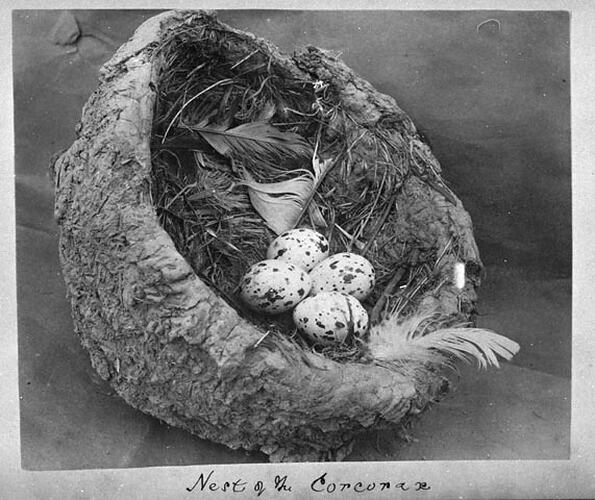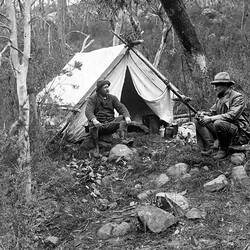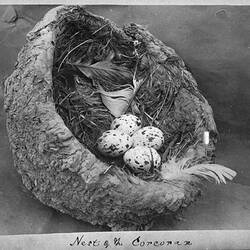WHITE-WINGED CHOUGH - Corcorax Melanorhamphus, Veillot (298)
Geographical Distribution - Queensland, New South Wales, Victoria and South Australia.
Nest - Large, bowl shaped, composed of coarse cemented mud scantily lined inside with matted stringy-bark, grass, and sometimes with fur and feathers, and conspicuously placed on any convenient horizontal limb of a tree in open forest or belt of timber. (See illustrations.) Dimensions over all of an average nest, 8 ½ inches by 6 ½ inches in depth; egg cavity 7 inches across by 3 inches deep.
Eggs - Clutch, five to seven usually, eight or more occasionally; inclined to be elliptical in shape; texture of shell comparatively strong, with glossy surface; colour, whitish or light yellowish-white, moderately but boldly blotched with irregular-sized patches of olive-brown and dull-slate, the latter colour underlying the surface of the shell. Dimensions in inches of a pair from an incomplete clutch of three taken near Pyramid Hill, Victoria, 6th October, 1884: (1) 1.58 x 1.11, (2) 1.53 x 1.11; of a proper clutch of five eggs (seven birds to the family) taken near the Murray, Riverina, 5th November, 1892: (1) 1.64 x 1.14, (2) 1.53 x 1.14, (3) 1.56 x1.14, (4) 1.51 x 1.10, (5) 1.41 x 1.12. (Plate 5.)
Observations - There is much of interest surrounding the Corcorax. Not only is the bird a unique or anomalous kind, but as a common forest species throughout the greater part of Australia, little is under-stood of its natural habits. Its total length is given at 16 to 19 inches; wing, 10 inches; tail, 9 inches; a somewhat slender bill is 1 ¾ inches, while the black plumage with its glossy-green reflections is set off with scarlet eyes. All our native birds are more or less infested with vermin. Some specimens of the Chough are very repulsive in this respect.
Gould says the Chough occurs in small troops of from six to ten in number. During a recent inland excursion, I was careful to count the individuals of various families, which numbered respectively six, seven, seven and six. On another occasion I was present at the taking of a nest, where seven birds appeared in a very excited manner. Of course there may be larger flocks when augmented by the season's young. Mr. Chas McLennan witnessed in the Mallee, one autumn, a large flock of over 100 Choughs. The great naturalist also says, 'It has often struck me that more than one female deposits her egg in the same nest, as four or five females may be frequently seen either on the same or neighbouring trees, while only one nest is to be found.'
Mr. A. J. North writes, 'As many as eight eggs have been taken from one nest. It would appear therefore that more than one bird lays in a single nest. It is well known that often more than one pair of birds assists in the construction of one nest.'
However, I think the actual proving of the interesting fact rests with my friend, Mr. Hermann Lau. Let his own words attest. 'The Black Magpie (Corcorax) is gregarious, living in small troops of from five to fifteen, and is dispersed all over the Downs (Darling). Together they commence building one nest, its material being simply mud mixed with dry grass, and often here and there I have found pebbles the size of a marble embedded. If the soil from which the stuff is taken is black, as on the plainy Downs, the nest shows that colour; on the other hand, if of a loamy character, as at Warroo and vicinity, the colour is lighter. The lining consists in the first-named case of dry grass and in the second mostly of opossum hair, on which five or six eggs rest. The whole company attend to one nest, as I have proved, shooting two birds from the nest, and seeing a third sitting the next day. As soon as the young are hatched, another nest gets built, and so on until Christmas (commencing in September), so that three broods may be expected. At Warroo, September, 1879, I sent my black man up a tree to fetch me a nest, with the complement of eggs. The nest weighted 7 ¾ lbs.'
With regard to the nesting of the Chough, there still remains two important points to be settled: - What is the proportion of male and female birds to one family or nest? and, Do the females lay each one or more eggs?
An exceedingly large nest of this remarkable species taken in the Swan Hill district, 1893, by Mr. Robert Hall, of the Field Naturalists' Club, weighed no less than 9 lbs. 6 ozs.
It may not be generally known that the Chough is, at seasons, a nuisance to farmers. A correspondent in the Mangalore district, Victoria, informs me these birds give some trouble in the newly-sown fields by pulling up grain just as it is germinating.
Breeding months are August to December.
Resources
Transcribed from Archibald James Campbell. Nests and Eggs of Australian Birds, including the Geographical Distribution of the Species and Popular Observations Thereon, Pawson & Brailsford, Sheffield, England, 1900. Transcribed from pages 65-66.
More Information
-
Keywords
-
Authors
-
Contributors
-
Article types


